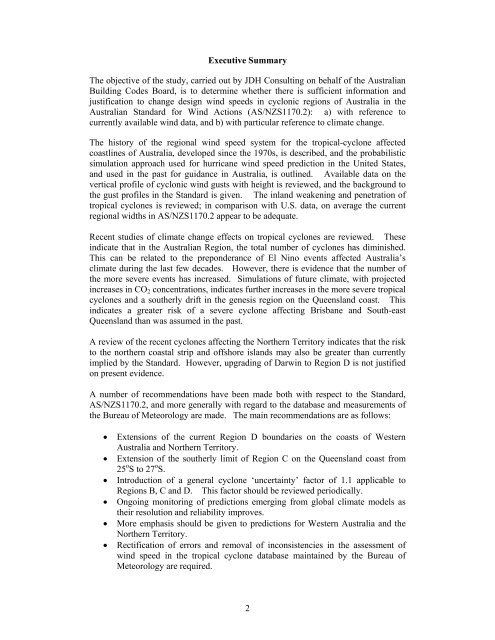PDF | 2 MB - Australian Building Codes Board
PDF | 2 MB - Australian Building Codes Board
PDF | 2 MB - Australian Building Codes Board
Create successful ePaper yourself
Turn your PDF publications into a flip-book with our unique Google optimized e-Paper software.
Executive Summary<br />
The objective of the study, carried out by JDH Consulting on behalf of the <strong>Australian</strong><br />
<strong>Building</strong> <strong>Codes</strong> <strong>Board</strong>, is to determine whether there is sufficient information and<br />
justification to change design wind speeds in cyclonic regions of Australia in the<br />
<strong>Australian</strong> Standard for Wind Actions (AS/NZS1170.2): a) with reference to<br />
currently available wind data, and b) with particular reference to climate change.<br />
The history of the regional wind speed system for the tropical-cyclone affected<br />
coastlines of Australia, developed since the 1970s, is described, and the probabilistic<br />
simulation approach used for hurricane wind speed prediction in the United States,<br />
and used in the past for guidance in Australia, is outlined. Available data on the<br />
vertical profile of cyclonic wind gusts with height is reviewed, and the background to<br />
the gust profiles in the Standard is given. The inland weakening and penetration of<br />
tropical cyclones is reviewed; in comparison with U.S. data, on average the current<br />
regional widths in AS/NZS1170.2 appear to be adequate.<br />
Recent studies of climate change effects on tropical cyclones are reviewed. These<br />
indicate that in the <strong>Australian</strong> Region, the total number of cyclones has diminished.<br />
This can be related to the preponderance of El Nino events affected Australia’s<br />
climate during the last few decades. However, there is evidence that the number of<br />
the more severe events has increased. Simulations of future climate, with projected<br />
increases in CO 2 concentrations, indicates further increases in the more severe tropical<br />
cyclones and a southerly drift in the genesis region on the Queensland coast. This<br />
indicates a greater risk of a severe cyclone affecting Brisbane and South-east<br />
Queensland than was assumed in the past.<br />
A review of the recent cyclones affecting the Northern Territory indicates that the risk<br />
to the northern coastal strip and offshore islands may also be greater than currently<br />
implied by the Standard. However, upgrading of Darwin to Region D is not justified<br />
on present evidence.<br />
A number of recommendations have been made both with respect to the Standard,<br />
AS/NZS1170.2, and more generally with regard to the database and measurements of<br />
the Bureau of Meteorology are made. The main recommendations are as follows:<br />
• Extensions of the current Region D boundaries on the coasts of Western<br />
Australia and Northern Territory.<br />
• Extension of the southerly limit of Region C on the Queensland coast from<br />
25 o S to 27 o S.<br />
• Introduction of a general cyclone ‘uncertainty’ factor of 1.1 applicable to<br />
Regions B, C and D. This factor should be reviewed periodically.<br />
• Ongoing monitoring of predictions emerging from global climate models as<br />
their resolution and reliability improves.<br />
• More emphasis should be given to predictions for Western Australia and the<br />
Northern Territory.<br />
• Rectification of errors and removal of inconsistencies in the assessment of<br />
wind speed in the tropical cyclone database maintained by the Bureau of<br />
Meteorology are required.<br />
2
















